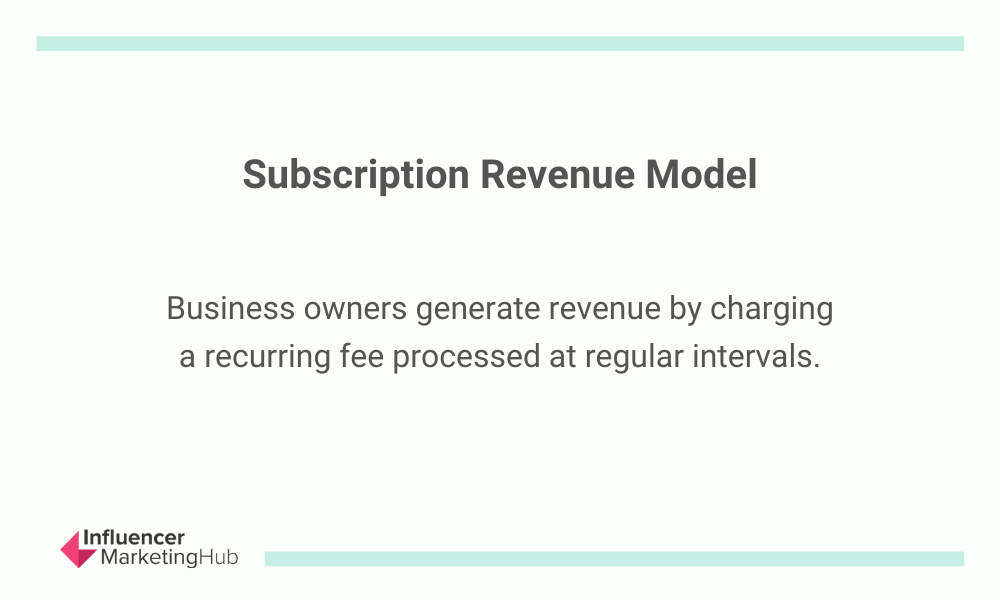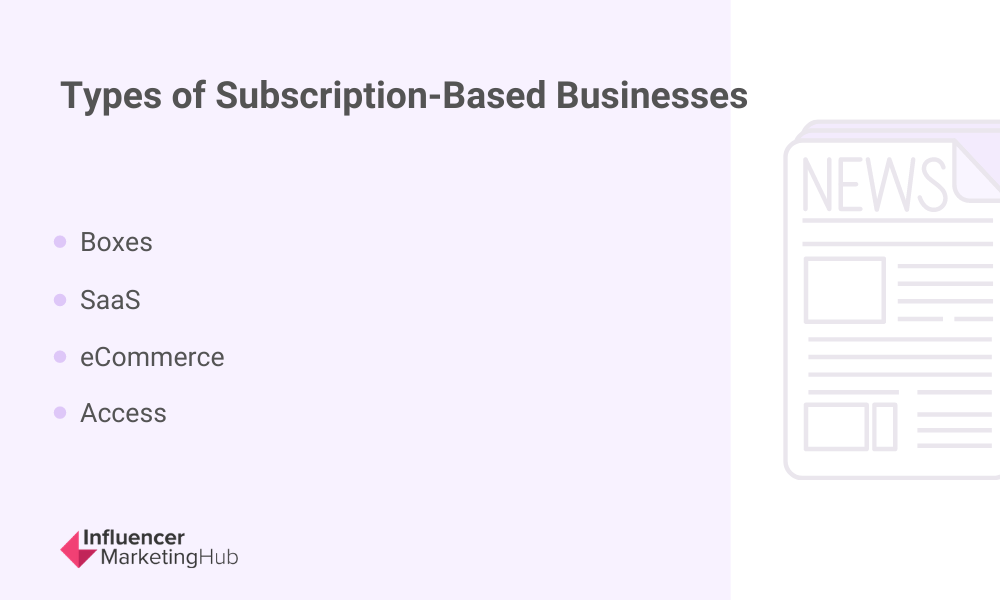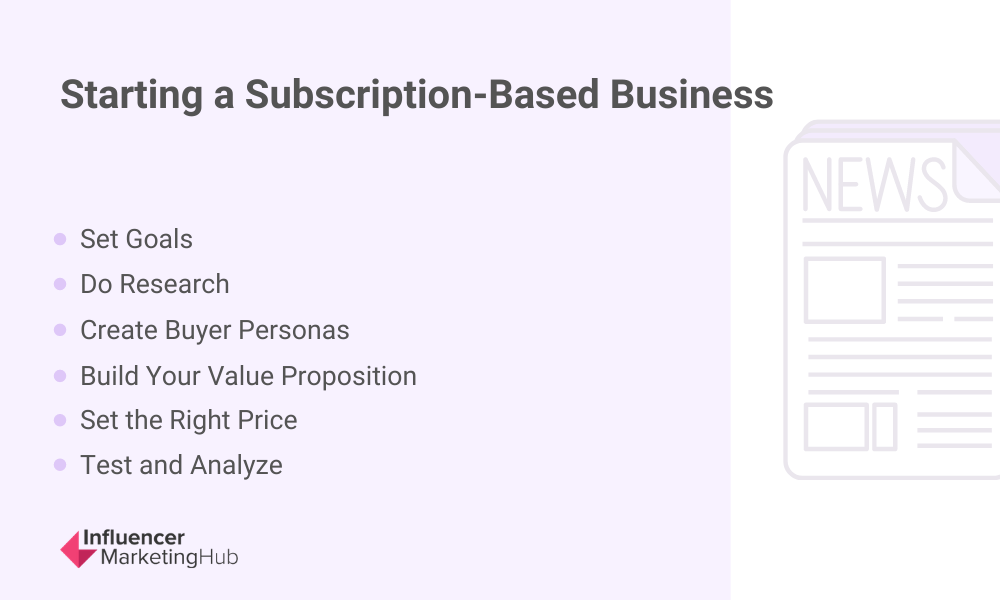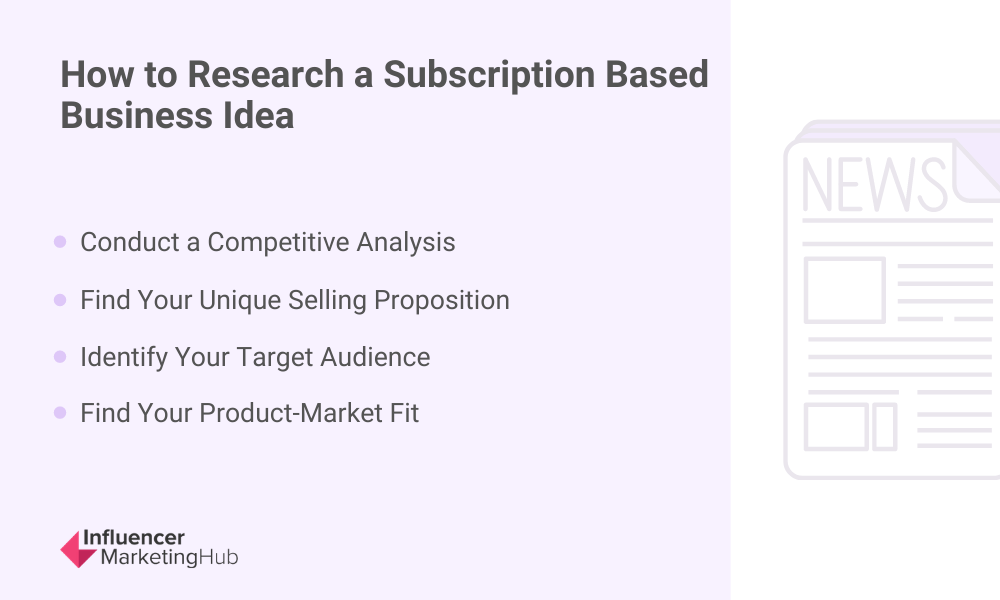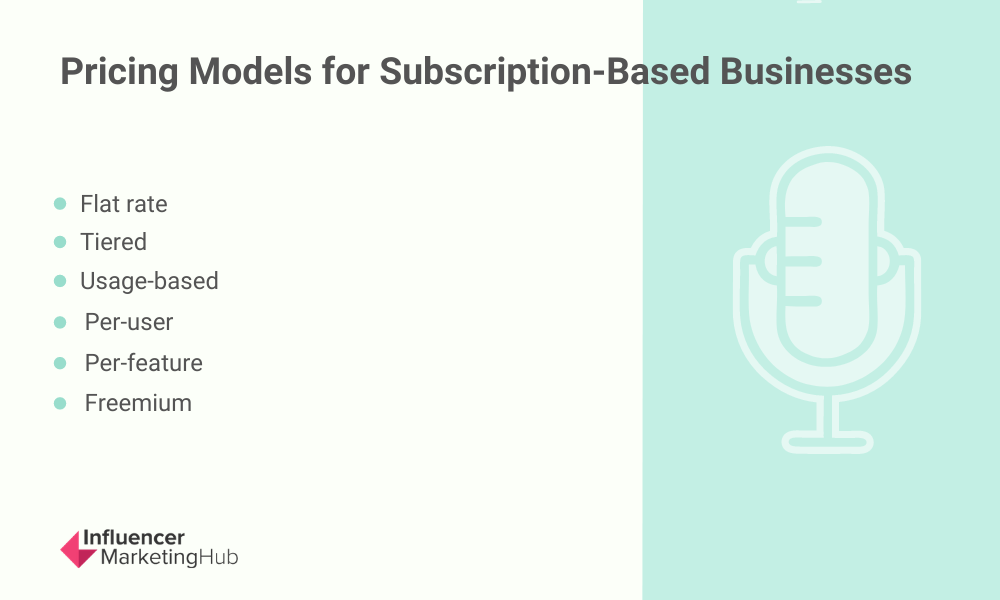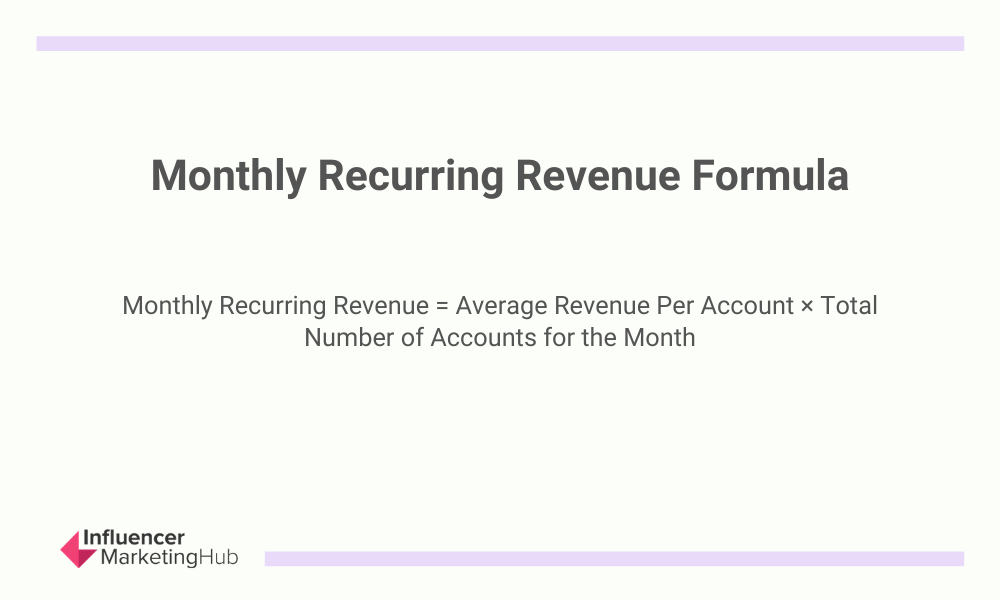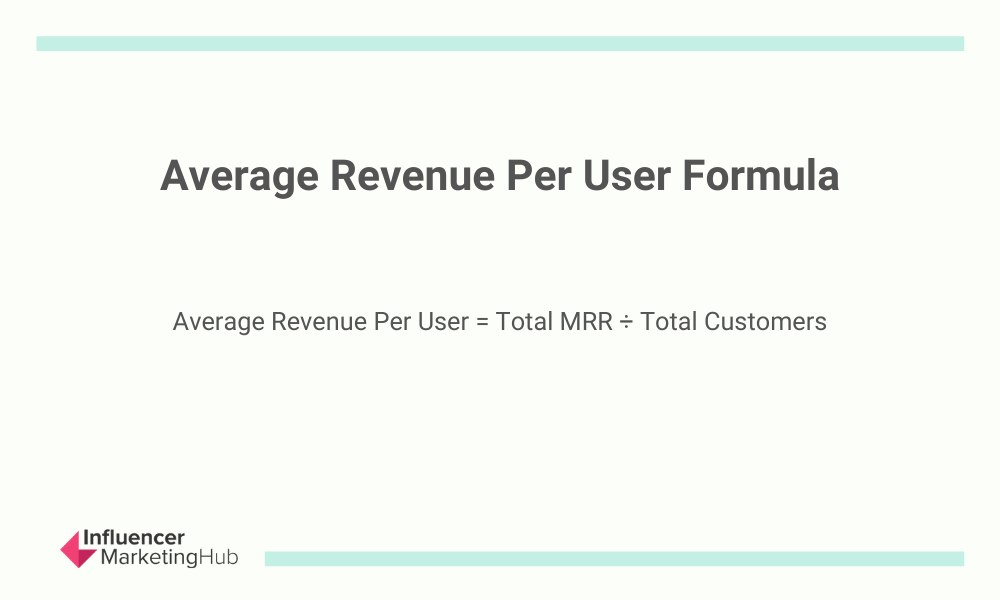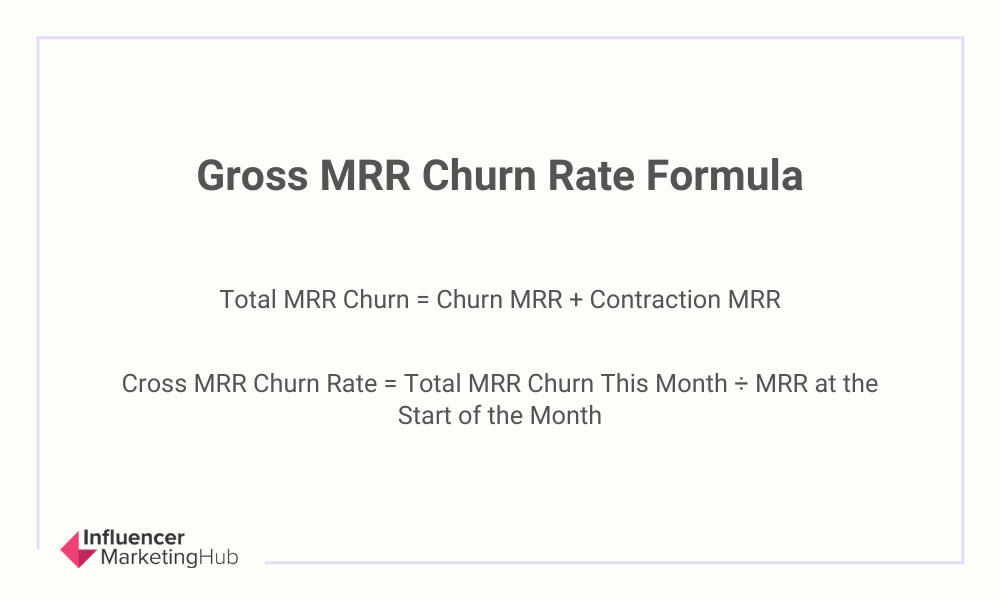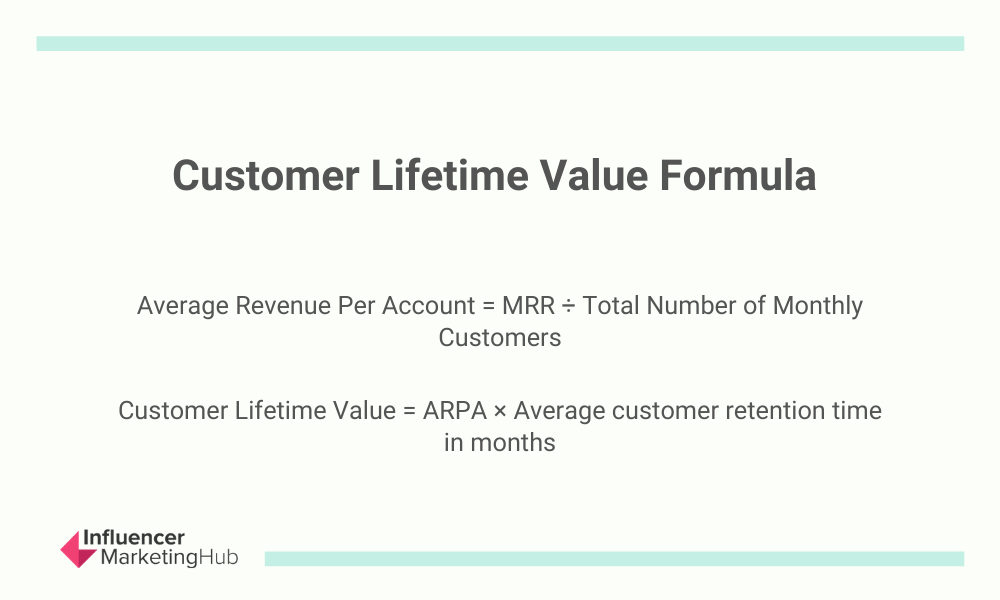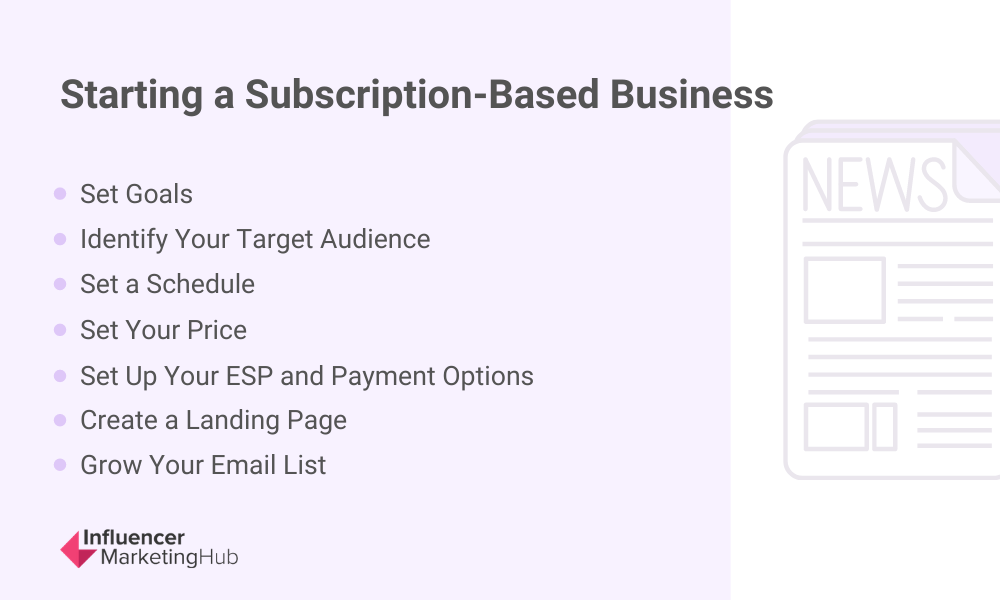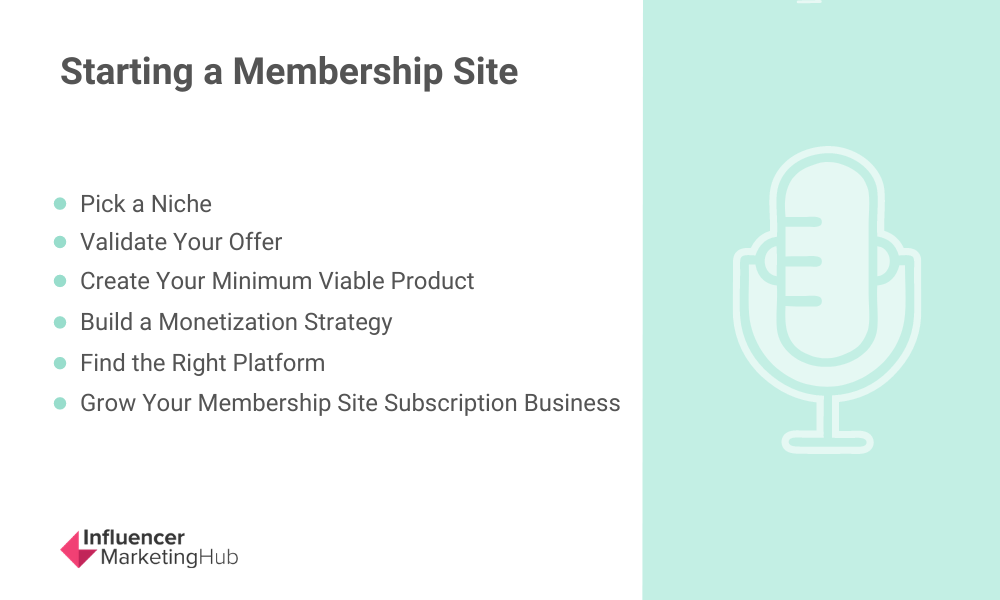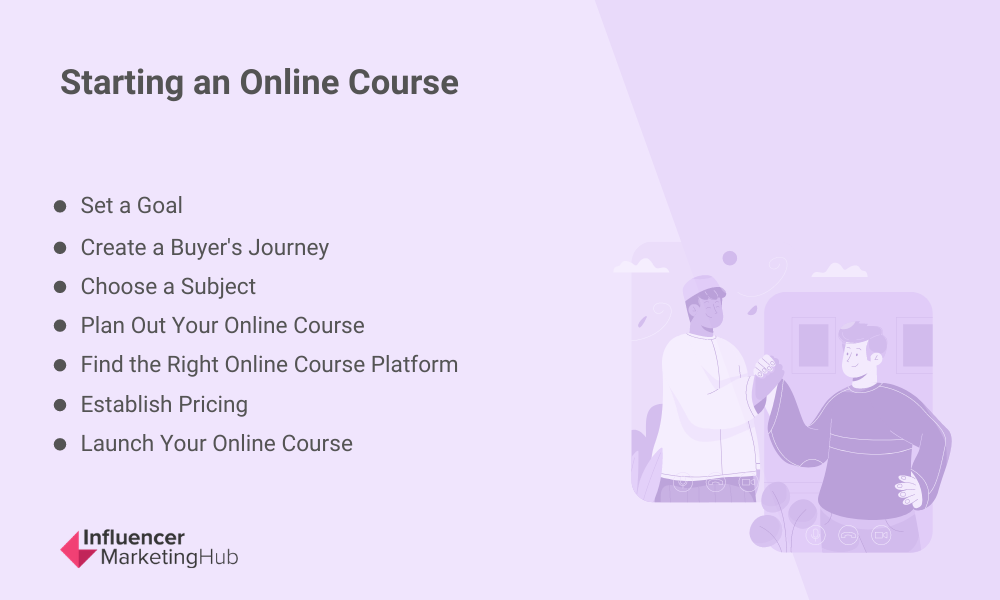Subscription-based business models are nothing new. Things like Netflix, Spotify, and your email marketing service are all subscription-based services. And subscription-based business is booming. The latest research shows that subscription-based businesses are getting 5X faster revenue growth than the S&P 500 to the tune of 18.2% vs. 3.6%.
Part of the reason that subscription-based businesses are thriving is that technology makes it easy. Business owners can upload content, live stream, and accept payments with ease. Plus, CRM software mixed with email marketing makes staying in touch with customers to build and nurture those relationships easier than ever before.
But a lot goes into turning a profit.
That's why we've decided to put together this guide that will teach you how to start a subscription-based business that actually makes money. In this guide, you'll learn what the subscription revenue model is and how it differs from regular revenue, types of subscription-based businesses, and how to start a subscription-based business of your very own. We start with instructions that will help you start a subscription business on any platform before getting into how to start subscription-based businesses for email newsletters, membership sites, premium content sites, and online courses.
Want to find out your earnings potential? Check out our Subscription Revenue Calculator.
Monthly Recurring Revenue Calculator
Calculate your total revenue on a month by month basis.
Revenue breakdown
Month
Year
How to Start a Subscription-Based Business That Actually Makes Money:
- What Is the Subscription Revenue Model?
- Subscription Revenue vs. Regular Revenue: What's the Difference?
- Types of Subscription-Based Businesses
- How to Start a Subscription-Based Business
- How to Start an Email Subscription Business
- Set a Goal
- Create a Buyer's Journey
- Choose a Subject
- Plan Out Your Online Course
- Find the Right Online Course Platform
- Establish Pricing
- Launch Your Online Course
- How to Create a Membership Site
- How to Sell Premium Subscription-Based Content on OnlyFans, Patreon, and More
- How to Create an Online Course
- Set a Goal
- Create a Buyer's Journey
- Choose a Subject
- Plan Out Your Online Course
- Find the Right Online Course Platform
- Establish Pricing
- Launch Your Online Course
- Marketing Your Subscription-Based Business
What Is the Subscription Revenue Model?
Through the subscription revenue model, business owners generate revenue by charging a recurring fee processed at regular intervals. When subscription-based businesses are able to cultivate long-term customer relationships, this results in recurring income that compounds over time as long as businesses are working to continue adding additional customers and retain the customers they already have.
Subscription Revenue vs. Regular Revenue: What's the Difference?
There are two key differences between subscription revenue and regular revenue: recurring payments and the importance of customer retention. No matter what you're selling, if you're using the subscription revenue model, you'll want to be sure that you're providing continuing value to your customers so they continue to subscribe.
Remember, with subscription-based businesses, you're likely selling your products and services at a lower cost than you would if the customer were going to buy everything all at once. This means that it takes time to earn a profit on your subscription-based business. However, if you can hang onto your subscribers, it has the potential to be quite a lucrative relationship. This differs from a regular revenue model in which you sell a product, the customer pays for it, and you might not see them again for six months, if ever.
Types of Subscription-Based Businesses
It's pretty safe to say that the subscription-based business model isn't going anywhere. With the proliferation of subscription boxes and SaaS businesses, it's likely that we're going to see more subscription-based businesses going forward, not less. Let's take a look at some of the more common types of subscription business you might come across.
Boxes
You can get just about anything in a subscription box these days. From pet supplies and toys to make-up to tea and beyond, there's probably a subscription box for it.
SaaS
So many software companies have gone for a SaaS (Software-as-a-Subscription) service model. If the software can be used online, it's likely to have a subscription-based model. This goes for everything from accounting software like QuickBooks to email marketing services.
eCommerce
This type of subscription-based business is similar to the subscription boxes we've already talked about. Instead of paying for a box of products, however, you might be paying for recurring shipments of consumable supplies like toilet paper, razor blades, or electric toothbrush heads.
New to eCommerce? Here’s how to start an eCommerce business in 2021.
Access
These subscriptions give you access to private content. Netflix, Spotify, and OnlyFans fall into this category as do countless others. With these services, you're typically paying for on-demand content or other perks (like free shipping).
How to Start a Subscription-Based Business
Now that you understand a bit more about subscription-based businesses, you're probably wondering how to go about starting your own. In this section, we share steps you can take to create your own subscription-based business no matter what you want to sell.
1. Set Goals
What are you hoping to accomplish with your subscription-based business? No matter whether your goal is to hit a specific revenue, sell a specific number of subscriptions, or getting a certain number of customers, you need to figure it out. This will help you target the right audience and set the right pricing.
We encourage you to set both short-term and long-term goals. The short-term goals help you stay on track so you're sure to achieve those long-term goals. They work very well together to keep your marketing strategy agile so you can better adapt to changes.
2. Do Research
Once you have your goals set, it's time to research. That means taking a very close look at your competitors, product-market fit, and discovering your target audience.
Conduct a Competitive Analysis
Taking a look at what your competitors are doing will help you make your product and your messaging even better. You'll want to consider:
- Which companies offer similar products
- The features they have and what they're missing
- How their customers feel about them (this is a good chance to find out what customers want and aren't getting)
- What their messaging is like
Social listening is a great tool you can use for competitive analysis. This is the practice of analyzing social media messages, comments, mentions, and more on a specific topic.
Find Your Unique Selling Proposition
After you have a better understanding of what your competitors are doing, you can figure out the gaps in the market. This is especially important if you're trying to offer a product or service that others are already offering. You need to be unique and set yourself apart from your competitors. What is your unique selling proposition? What is it about your subscription-based business that customers can't get from anyone else?
Identify Your Target Audience
Your subscription-based business is going to fail spectacularly if you don't find the right audience. Remember, you want subscribers to continue paying for your product or service month after month, indefinitely. Figure out what pain points your product or service solves and find the people looking for that solution. Why might people need what you have to offer? What's going on in their lives that has them seeking out the specific solution you have to offer?
Find Your Product-Market Fit
Product-market fit simply means where your subscription-based business fits into the market. This research helps you validate your business and understand how many people are in need of the solution you have to offer. Once you've shown that there's a need, you know you have a viable offer.
3. Create Buyer Personas
After completing research on your competitors, you'll have a lot of information about your target audience that you can use to create buyer personas. A buyer persona is a detailed profile of a fictional person who represents your target audience or ideal customer. If your subscription business is B2B, your buyer personas will be representations of your perfect fictional client business or brand. No matter if you're a B2B or B2C business, however, you're very likely to end up with more than one buyer persona.
In fact, we recommend creating three to five buyer personas. And you might have even more than that once you get into demographics, behaviors, psychographics (hobbies, spending habits, values, etc.), and the other ways your customers may be segmented.
Some businesses might call that good and skip out on creating buyer personas because they think they're too much work.
Don't do that.
Buyer personas are a vital part of the process when it comes to building a successful subscription-based business. According to research by customer intelligence firm Cintell, companies that exceed lead and revenue goals are twice as likely to create buyer personas than those who don't. Not only that, but 93% of companies who exceed lead and revenue goals report segmenting their database by persona.
To start building your buyer personas, take another look at the data you've already collected about your target audience and start segmenting it. Note the characteristics of your potential customers, what they're like, and how you can reach them. Once you have your audience segmented into three to five (or more) buyer personas, start to flesh out those personas as though they're real people before moving on to building marketing strategies you might use to target those buyers.
4. Build Your Value Proposition
Where your unique selling proposition is about where you are in relation to your competitors, your value proposition is more customer-focused and focuses on how your subscription-based business will improve their lives. This makes it a lot easier for potential customers to justify signing up. Take the time to build an obvious value proposition so your customers have no doubt what's in it for them. This might mean:
- Directly explaining the value of your subscription business to your customers, preferably with facts and figures to back your claims up.
- Show potential customers how you differ from your competitors and why choosing you just makes sense.
- Draw people into your brand and business, encouraging them to learn more.
Building your value proposition will give you the targeted message you want to share with your potential customers to turn them into paying customers.
5. Set the Right Price
There are several different pricing models you can use for your subscription business.
- Flat-rate: offering set features at a fixed price
- Tiered: offering different sets of features at different pricing.
- Usage-based: the "pay as you go" model where customers only pay for what they use
- Per-user: customers pay based on how many people are using it
- Per-feature: customers pay based on specific product features
- Freemium: customers can try out your product (usually with limited features) for a trial period
No matter what pricing model you start with, or what price point you set, just remember that you really can change it. Just look at how many times Netflix has changed its pricing over the years. You can and should test and analyze your pricing as your subscription business grows.
6. Test and Analyze
After doing competitor research, building comprehensive buyer personas, creating your value proposition, and setting your price it's time to test out your strategy. One of the most common ways to do this is with a beta launch or field trial. Here's how to conduct a beta launch:
- Find users. Look for testers who match your buyer personas so you'll get valuable information from the people who are most like your target customers.
- Get feedback. You'll want both quantitative and qualitative feedback from your test users. Quantitative feedback is numerical (yes or no, rated on a scale, etc.) and provides data that can be used to find patterns and make predictions. Qualitative feedback is non-numerical (text, video, or audio responses). This data helps you understand concepts, opinions, and experiences so you can get deeper insight or generate new ideas.
- Tweak your offer. Based on the feedback you receive, make adjustments to your offer and try again.
You don't need to limit yourself to doing beta tests only at the beginning. You can use them for changes to your offer whenever you want. They're a great way to get a better understanding of your audience and what works for them.
You'll also want to track a few important metrics for your subscription-based business to ensure that you're performing the way you want:
Customer Acquisition Cost (CAC)
CAC is the average amount you spend on getting a new customer. This includes all of your sales and marketing costs. This metric can help you plan spend for future marketing campaigns. Here's the formula:
Monthly Recurring Revenue (MRR)
MRR is the monthly revenue that comes in from your subscriptions and is a good indicator of your business's health. When you're just starting out, aim for an MRR in the double digits—10%–20%. Here's the formula:
Average Revenue Per User (ARPU)
ARPU is the average revenue brought in from each subscription over a specific timeframe. This shouldn't include free or freemium users. This number can tell you if you have too many customers in either high or low-priced plans. If you have a lot of customers paying for the high-priced products, there's a good possibility that many of those users would gladly pay more. If you have too many customers in the low-priced plans, however, you probably need to improve your marketing or increase the value of your higher-priced plans so subscribers find them to be worth the extra money.
Here's how to calculate ARPU:
Gross MRR Churn Rate
Your churn rate is the rate at which subscribers are canceling their subscriptions. A high churn rate is a big problem for subscription-based businesses because you're losing customers at too rapid of a rate. Here's the formula:
Lifetime Value (LTV)
CLV is the average amount of revenue brought in by a specific customer over the life of that customer (how long they've been a customer). This can help you understand how much money you should allocate to marketing to get new customers. Here's the formula:
Now that you know the basics of how to start a subscription-based business, let's talk about a few excellent subscription-based businesses that are both easy to start and lucrative to run.
How to Start an Email Subscription Business
Did you know that you can use an email newsletter as a profitable subscription business? Paid newsletters will help you generate recurring revenue but it takes a lot of hard work to keep your email newsletter compelling and valuable enough to keep subscribers coming back each month. In this section, we're going to show you how you can start an email subscription business.
Set a Goal
What do you hope to accomplish with your paid newsletter? What's your topic? How can you create enough value around that topic that people will pay you for it? A good starting place is to think about what you have expert knowledge about that you want to share with others. That's your niche. From there, you can write about anything as long as it's valuable to your audience and moves you toward your goal.
Create a Buyer's Journey
Creating a buyer's journey will help you create a solid sales strategy that moves potential customers through your marketing funnel. But there are some steps you need to take before you can create a buyer's journey.
First, you need to identify your ideal student. We recommend looking back through the section about creating a buyer persona and create buyer personas for each of the types of people you're targeting. Keep in mind not only what your target audience looks like but also how your online course can benefit them.
Choose a Subject
What course are you going to offer? Your subject has to be something valuable to your target audience, something that will help them advance in their career or grow in their personal life. Most online courses fit in one of these groups:
- Expertise. If you're an expert in a certain field or subject, create an online course for it.
- Personal experience. You don't have to be a professional to have knowledge about a topic that people will pay to learn about. You can draw on your personal experience to create a high-quality and valuable course.
- New to you. If you don't have the expertise or personal experience in a topic, you can still create a great course about it. Sharing what you're learning in real-time is very helpful for the people who are also curious about your topic but don't want to go it alone.
Before you commit to a topic, be sure to check out your would-be competition to make sure that you have a full understanding of what's already available on your topic. Don't shy away from topics that have high competition—it just means that there's demand there. Of course, you don't want to fight with your competitors for scraps, so we recommend choosing a topic that has a nice, middle-of-the-road level of competition.
Plan Out Your Online Course
Start by creating an outline of what you'll cover in your course. With that outline, you'll have a better understanding of how many lessons your course will need. You'll also want to look for ways you can increase your course's value and price through upsells and bonus content.
After you've outlined your course, you'll need a way to make it pretty, create an online course landing page, and deliver it.
Find the Right Online Course Platform
There are quite a few online course platforms available, from all-in-one solutions like Thinkific to learning marketplaces like Udemy. You can even build them into your own site if you want to host everything on your own. With all of the options you have available to you, here are some things you can look for to narrow down your online course platform choices for your subscription-based business:
- Community. An engaged online community is a big selling point for online courses. The platform you choose should include a community element so students can develop relationships and learn from one another.
- Dynamic courses. You don't want to deliver a block of text. You can, of course, but courses with dynamic content like images, videos, downloads, GIFs, and more will be a much bigger draw for potential students.
- Expansion. You're probably not going to stop at a single course, so look for a platform that makes it easy to add additional content and more courses... and maybe even add breakout and mastermind groups.
- Portability. Everyone is on their mobile devices these days. Find an online course platform that will be with students wherever they are, accessible from both desktop and mobile devices.
Establish Pricing
Online course pricing varies widely. That makes figuring out the right price for your subscription-based online course a bit tricky. When you're working out pricing for your course, here are some things to take into account:
- How long it took you to create the course
- The quality of the course and associated content
- How involved you (or the instructors) will be in providing live sessions, feedback, etc.
- The value the course creates for students in the long-term
When setting the price for your course, it can help to look to your competitors to find out what they're charging for their courses. You'll also want to consider your target audience and how much they can afford or are willing to pay.
Launch Your Online Course
You're ready to launch! We recommend launching your course to a small group before releasing it to the world. This gives you a chance to test your course and get feedback from your testers so you can tweak your course before your full launch. If your test launch goes well, or you've adopted the necessary changes, you're ready to market your online course to the world.
1. Set a Goal
What do you hope to accomplish with your paid newsletter? What's your topic? How can you create enough value around that topic that people will pay you for it? A good starting place is to think about what you have expert knowledge about that you want to share with others. That's your niche. From there, you can write about anything as long as it's valuable to your audience and moves you toward your goal.
2. Identify Your Target Audience
Here we are again with the target audience. If you're in marketing or an influencer, you're never going to get away from needing to identify your target audience. These are the people who are interested in what you have to say. So interested, in fact, that they're willing to pay for it. When you define your target audience, you can create targeted marketing campaigns that bring in new subscribers and keep your existing subscribers from leaving.
3. Set a Schedule
Nobody is going to pay for an email newsletter that comes out randomly. Subscribers want to know what they're signing up for and a big part of that is knowing when they should expect your email newsletter to arrive. Depending on whether your email newsletter subscription is your main job or just a side hustle you can set a schedule that works for you, be that daily, weekly, monthly, or less frequently. What's most important is to set your schedule and communicate to subscribers what that schedule is. And then stick to it.
4. Set Your Price
We've already covered the various pricing models you can use for your subscription-based business so refer to that section for a refresher. Most paid subscriptions are priced between $2–$15 per month. However, we recommend doing some research into your competitors and how much they charge for paid email newsletter subscriptions. Just remember that the higher your price point, the more value you need to provide.
5. Set Up Your Email Marketing Service and Payment Options
Start by connecting your payment platform (PayPal, Stripe, etc.) to your email marketing service. Since payment platforms and email marketing services are so different, you'll want to check the documentation for your specific platforms.
6. Create a Landing Page
It may be tempting to just push your paid email newsletter subscription anywhere on your website you can, it makes a huge difference having a dedicated landing page to sell the subscription. This way, you can go into detail about what subscribers will get for their ongoing investment and how often you'll be sending emails among other things. A custom landing page makes it a lot easier to sell just about anything.
7. Grow Your Email List
If you're starting a paid email newsletter subscription, it should come as no surprise that you need to grow your email list. One of the easiest ways to do that is to add opt-ins to your website, encouraging users to sign up. These users will be signing up for your free email newsletter. You can then use your free newsletter to market the paid version.
At this point, you're ready to create your first paid email newsletter and get started!
How to Create a Membership Site
Membership sites can be either paid or free (or both) and involve gating (locking or hiding) certain content or sections on your website. This gated content is only available after people subscribe. There are different types of membership sites:
- Drip feed. Subscribers pay a monthly payment for access to a members' area with new content added each month.
- All-in. Subscribers get access to all the content at once. You'll want to be sure to add something valuable that happens on a recurring basis to keep subscribers around.
- Online community. Subscribers pay a fee for access to private forums and groups.
- Service. Subscribers pay for a service that includes access to resources and tools through a membership section.
Online courses could also be considered membership sites but we think they deserve their own section so we'll be showing you how to start an online course later in this guide. For now, let's talk about how you can create a membership site of your own.
1. Pick a Niche
Finding the right niche is one of the most important steps to creating a membership site that brings in recurring revenue. There are truly limitless niches out there but not all of them are going to make you money. Some of the more popular niches are health and fitness, finance, beauty, fashion, and entertainment. Of course, those are pretty broad topics with pretty big competitors. Instead of choosing such a broad niche, you'll want to drill down into your chosen niche to find something that doesn't have a ton of competitors but that is still a viable and profitable niche. For example, instead of trying to perform well in the broad topic of health and fitness, you might choose to focus on yoga. But not just yoga, which is still a pretty broad topic. You'll continue to drill down to find a niche that has a large audience and just a few competitors like "yoga for neurodiverse people" or "yoga for people with chronic pain."
Once you have a few ideas for a niche, check out your competition and the market. Who are your competitors? What are they doing? What kinds of products and services are there? Are people paying for information in this niche?
2. Validate Your Offer
So, you've chosen a niche. Now it's time to take a much closer look at your competitors to find out what they're offering, who is taking them up on those offers, how they're targeting potential customers, how successful they are, and more. You can also use SEO tools to find out if people are searching for your niche (the more people are searching for it, the higher the demand). Another great way to find out if your membership site offers something that people are looking for is to check online forums and social media to find out if people are talking about it.
3. Create Your Minimum Viable Product
If you've validated your offer, you probably already know if you have product-market fit. Now you need to move forward and create a minimum viable product (MVP) that you can start selling. This helps quite a bit with the paralysis we sometimes feel about product launches. Your membership site doesn't have to be 100% complete or perfect. Just create one high-quality piece that you can sell. Then, expand your offering as you get feedback from your subscribers. During this process, you'll likely find a core set of subscribers who are eager for everything you have to offer. Find out everything you can about these people. The people like them are the ones you want to target with your marketing.
4. Build a Monetization Strategy
How is your membership site going to make money?
If you answered "people are going to pay to join," you have more planning to do if you want your membership site to be profitable.
As always, your most successful competitors are a great source of information. Find out everything there is to know about their pricing. What does membership include? How do they present their product or service offering (if they're selling additional products or services)? How is their pricing structured (single price or multiple price points)?
These are the questions you'll need to answer about your own pricing and offering to create a monetization strategy.
5. Find the Right Platform
There are all sorts of membership platforms like Kajabi, FreshMember, and WishList Member that make it easy to create the membership site of your dreams. If you use WordPress.org to manage your website, there are several high-quality membership site plugins that will let you turn your WordPress website into a membership site with just a few clicks.
It's also important to find the right platform to handle payments. Some membership platforms include payment processing. If they don't, you'll need to find a payment processor that integrates with your membership platform so you don't have to manually track any of that information. Plus, you'll want to be able to easily create coupons, add and remove members, reach out to customers for billing updates, and more.
Once you've found the right membership site platform and payment processor, you're ready to create and publish your content based on the specifications of your chosen membership site platform.
6. Grow Your Membership Site Subscription Business
Member engagement is key to your growth. This might mean offering live webinars, members-only forums or Slack channels, private Facebook groups where members can interact with the business owner, and more. The goal is to create a membership site that keeps subscribers engaged and feeling like they're constantly getting value from their investment. You can also use their feedback and comments to guide your future features, services, and products.
How to Sell Premium Subscription-Based Content on OnlyFans, Patreon, and More
OnlyFans has skyrocketed to fame over the past couple of years and with good reason. The platform makes it so easy for people to offer private content in exchange for money. But it's not the only option. Patreon is another enormously popular premium subscription-based content platform that creators use to share premium content with subscribers. Here are a few other premium subscription-based content platforms:
- IsMyGirl. Sell monthly subscriptions, message fans, create custom content by request, and more.
- IsMyGuy. The men-only alternative to IsMyGirl.
- LoyalFans. Sell monthly subscriptions, message fans, create custom content by request, and more.
- MYM.fans. Sell monthly subscriptions, message fans, create custom content by request, and more.
- FanCentro. Sell monthly subscriptions, message fans, create custom content by request, and more. You also get landing pages to help promote your page.
As you can see, many of the premium subscription-based content platforms that are great alternatives to OnlyFans all have similar service offerings. There are also tons of alternatives to Patreon that you can use to monetize your content:
- Buy Me a Coffee. A donation-based membership platform that accepts one-off and monthly support from your fans.
- Ko-fi. Similar to Buy Me a Coffee, subscribers can make monthly donations for creators.
- SubscribeStar. An independent membership platform catering to educators, musicians, and visual artists.
- Anchor Listener Support. A Patreon-style subscription service that allows creators to receive recurring donations from fans.
How to Create an Online Course
Online courses are a brilliant way to increase recurring monthly revenue and they're surprisingly easy to create. They're made even better with the addition of an online community for course participants. Here's how you can create an online course that sells.
Set a Goal
What do you hope to accomplish with your paid newsletter? What's your topic? How can you create enough value around that topic that people will pay you for it? A good starting place is to think about what you have expert knowledge about that you want to share with others. That's your niche. From there, you can write about anything as long as it's valuable to your audience and moves you toward your goal.
Create a Buyer's Journey
Creating a buyer's journey will help you create a solid sales strategy that moves potential customers through your marketing funnel. But there are some steps you need to take before you can create a buyer's journey.
First, you need to identify your ideal student. We recommend looking back through the section about creating a buyer persona and create buyer personas for each of the types of people you're targeting. Keep in mind not only what your target audience looks like but also how your online course can benefit them.
Choose a Subject
What course are you going to offer? Your subject has to be something valuable to your target audience, something that will help them advance in their career or grow in their personal life. Most online courses fit in one of these groups:
- Expertise. If you're an expert in a certain field or subject, create an online course for it.
- Personal experience. You don't have to be a professional to have knowledge about a topic that people will pay to learn about. You can draw on your personal experience to create a high-quality and valuable course.
- New to you. If you don't have the expertise or personal experience in a topic, you can still create a great course about it. Sharing what you're learning in real-time is very helpful for the people who are also curious about your topic but don't want to go it alone.
Before you commit to a topic, be sure to check out your would-be competition to make sure that you have a full understanding of what's already available on your topic. Don't shy away from topics that have high competition—it just means that there's demand there. Of course, you don't want to fight with your competitors for scraps, so we recommend choosing a topic that has a nice, middle-of-the-road level of competition.
Plan Out Your Online Course
Start by creating an outline of what you'll cover in your course. With that outline, you'll have a better understanding of how many lessons your course will need. You'll also want to look for ways you can increase your course's value and price through upsells and bonus content.
After you've outlined your course, you'll need a way to make it pretty, create an online course landing page, and deliver it.
Find the Right Online Course Platform
There are quite a few online course platforms available, from all-in-one solutions like Thinkific to learning marketplaces like Udemy. You can even build them into your own site if you want to host everything on your own. With all of the options you have available to you, here are some things you can look for to narrow down your online course platform choices for your subscription-based business:
- Community. An engaged online community is a big selling point for online courses. The platform you choose should include a community element so students can develop relationships and learn from one another.
- Dynamic courses. You don't want to deliver a block of text. You can, of course, but courses with dynamic content like images, videos, downloads, GIFs, and more will be a much bigger draw for potential students.
- Expansion. You're probably not going to stop at a single course, so look for a platform that makes it easy to add additional content and more courses... and maybe even add breakout and mastermind groups.
- Portability. Everyone is on their mobile devices these days. Find an online course platform that will be with students wherever they are, accessible from both desktop and mobile devices.
Establish Pricing
Online course pricing varies widely. That makes figuring out the right price for your subscription-based online course a bit tricky. When you're working out pricing for your course, here are some things to take into account:
- How long it took you to create the course
- The quality of the course and associated content
- How involved you (or the instructors) will be in providing live sessions, feedback, etc.
- The value the course creates for students in the long-term
When setting the price for your course, it can help to look to your competitors to find out what they're charging for their courses. You'll also want to consider your target audience and how much they can afford or are willing to pay.
Launch Your Online Course
You're ready to launch! We recommend launching your course to a small group before releasing it to the world. This gives you a chance to test your course and get feedback from your testers so you can tweak your course before your full launch. If your test launch goes well, or you've adopted the necessary changes, you're ready to market your online course to the world.
Marketing Your Subscription-Based Business
Congratulations! Your subscription-based business is launched. Now what?
Marketing.
You've put a lot of work into getting your subscription-based offering ready for your target audience and now you need to do the work of promoting it. Fortunately, with the rise of social media, the steady reliability of email marketing, and the power of partnerships and influencer relationships, marketing your course can actually be pretty easy and even fun.
Email Marketing
Email marketing has the best ROI of any marketing channel with a 4200% return. That means that you have the potential to earn $42 for every $1 you spend. Your email list is the first and best place to begin marketing your subscription-based business. You can even use a free trial or mini-course to encourage your email subscribers to try out your subscription-based business.
Social Media Marketing
A social media presence is important for any business, but if you're selling a subscription-based product or service it's vital to be active on the social media platforms your target audience uses. Be sure to create a page or profile for your business on LinkedIn, Facebook, Twitter, Instagram, and any other social media platform that makes sense to reach the right audience. Beyond that, you'll need to employ social media marketing strategies to keep your audience engaged and excited about your brand and what you have to offer.
Partnerships and Influencer Marketing
Influencer marketing is a fantastic way to build excitement about your subscription-based business. You'll need to find an influencer that fits with your brand's personality and who appreciates and understands the products and services you're selling. And don't be afraid to reach out to your network to find other people and businesses to partner with.
Building a Subscription-Based Business That Sells
No matter what you're selling, a subscription revenue model helps you build revenue over time, spending less on continuously finding new customers. With the information we've provided here, you have everything you need to start a subscription-based business that sells.
